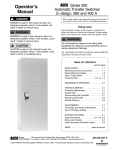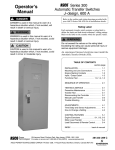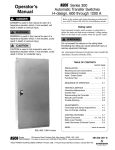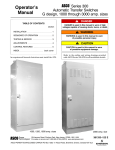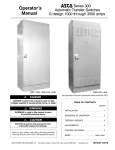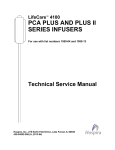Download ASCO POWER TECHNOLOGIES Series 300 Operator`s manual
Transcript
Accessory 11BG for Series 300 Installation Automatic Transfer Switches Accessory 11BG module includes a programmable engine– generator exerciser and power source availability contacts. It can be added to a Series 300 Automatic Transfer Switch (ATS) that has a Group 1 Controller. If an existing engine exerciser (Acc. 11CD) is already installed, it must be disconnected first. The Accessory 11BG module mounts directly behind the Series 300 ATS operator interface on the inside of the enclosure door. The module connects to the Series 300 ATS operator interface board and Group 1 controller. Kits K629830 & K749999 include the Acc. 11BG module, mounting hardware, and all necessary wiring. Tools required: 1/4”, 5/16” nutdrivers, small blade screwdriver your Series 300 ATS Operator’s Manual for setting the DIP switches J1 Figure 1. Accessory 11BG Module in kits. ELECTROCUTION – FLASH HAZARD Do not work on the transfer switch until both the utility and generator are off. Turn OFF both circuit breakers. Module Installation – Figures 2 & 3 1. With all power OFF, open the enclosure door. Locate the operator interface (membrane controls) mounted on the inside of the enclosure door. Use a 5/16” nutdriver to remove (counterclockwise) the four hex nuts from the corners of the operator interface. Do not remove the operator interface board (Figures 2 & 3). 2. Install (clockwise) four standoffs (from the kit) onto the four studs and tighten them with a 1/4” nutdriver. 3. Install the Acc. 11BG module on top of the operator interface so that four standoffs fit through the corner holes. Then install (clockwise) four 6–32 hex nuts (from the kit) to secure the assembly. Tighten the nuts. J3 Figure 2. Series 300 ATS operator Interface board mounted on the enclosure door (back view). remove 4 nuts (with captive lockwashers) Step 1 Connecting the Module – Figures 1, 2, 4 original mounting of Series 300 ATS operator interface on enclosure door 1. With all power OFF, locate the two ribbon cables and note direction and orientation of each cable. 2. Unplug the ribbon cable (coming from the Controller) from the operator interface (J3 lower right side) and reconnect it (same orientation) to the Acc. 11BG module (J1 lower right side). See Figures 1, 2, & 4. Step 2 Connect the new ribbon cable (coming from the Acc. 11BG module upper right side) to the operator interface (J3 lower right side) with the same orientation as the original cable that was moved. See Figures 2 & 4. Step 3 3. 4. Strip the insulation from both ends of the #16 gauge white wire (from the kit). Connect this prepared wire between Acc. 11BG module terminal 9 (right side) and the Group 1 Controller terminal 4 (bottom left). Figure 4. ASCO POWER TECHNOLOGIES L.P. stud add 4 standoffs reinstall 4 nuts operator interface board install Acc. 11BG board standoff added for Acc. 11BG Module Figure 3. Module installation hardware. 50 Hanover Road, Florham Park, New Jersey 07932 USA www.asco.com 381339–252 B page 1 2–line display 9 3 buttons connections for power source availability signal contacts J3 J1 J1 wiring Figure 4. Accessory 11BG module (mounted behind operator interface and connected to the controller) includes power source availability signal contacts and a programmable engine exerciser. Power Source Availability Signal Contacts The module provides one Form C contact each for the normal and emergency power sources to signal the acceptability of the source as sensed by the controller. The signal contacts operate in conjunction with the Source Available lights on the operator interface. Field wiring terminals are provided as shown in Figure 5 and the wiring diagram. Contact ratings: 2 amps @ 30 Vdc, 0.5 amp. @ 125 Vac resistive Figure 5. Power source availability signal contacts. Programmable Engine–Generator Exerciser Note: Refer to your Series 300 ATS Operator’s Manual to set DIP switches S1 & S2 in the Group 1 Controller. ASCO POWER TECHNOLOGIES L.P. Actuator 7 OFF Actuator 8 ON LOAD EXER ACTV LOAD S2 DIP Switch Settings in Series 300 ATS Group 1 Controller Programmable Exerciser Function ACTUATOR 5 OFF ON Enabled Actuator 5 OFF Disabled Actuator 5 ON EXT EXER 5 page 2 Enabled & Exercise with Load EXER ACTV 5 381339–252 B Actuator 7 OFF Actuator 8 OFF 8 See next page for instructions on setting the exerciser. Enabled & Exercise without Load 7 The programmable engine–generator exerciser incorporates a 7–day or 14–day time base. Proper Group 1 Controller settings must be made to determine whether or not the test will be done with or without load transfer (S1 DIP switch actuator 8). ACTUATORS 7 & 8 OFF ON 8 The Acc. 11BG module includes a programmable generator exerciser that provides for weekly or biweekly operation. The exerciser may have to be turned on (enabled) by setting S1 DIP switch actuator 7 to OFF (left position), and S2 DIP switch actuator 5 to OFF (left position). Programmable Exerciser Function 7 A backup battery in the Series 300 ATS Group 1 Controller (see Operator’s Manual, Sections 4 and 5) must be turned on to maintain the settings and to allow programming with the normal and emergency power sources turned off. S1 DIP Switch Settings in Series 300 ATS Group 1 Controller EXT EXER Shaded DIP switches are standard factory settings. 50 Hanover Road, Florham Park, New Jersey 07932 USA www.asco.com How to Set Optional Programmable Engine Exerciser (part of Acc. 11BG module) Start Time Display Hazardous voltage capable of causing shock, burns, or death is used in this transfer switch. Deenergize both Normal & Emergency power sources before programming the exerciser. Navigating the Menu Use the UP and DOWN arrow keys to move through the displays. Fast/Slow Adjust Daylight Saving Time Adjust Date The Start Time Display shows the engine exerciser start time. There are four parameters that determine the start time: weekly (”Every”) or bi–weekly (”Alt”) operation day of week (”Sun” through “Sat”) start hour (0 through 23) start minutes (0 through 59) For example, if the user wants the exerciser to run every other Saturday at 3 PM, the proper configuration would be: “Alt Sat @ 15:00” NOTE: When choosing bi–weekly operation, the exerciser will always run on the week designated “(1)” on the date display. Run Time Display The Run Time Display shows the run time for the engine exerciser. The default setting from the factory is 30 minutes. Time Display The Time Display shows the present system time. The format is “hours:minutes:seconds”. Time NOTE: During total power outages, power to the accessory is maintained by a battery in the Controller (see page 4–2 of Operator’s Manual). Be sure that the 9–volt alkaline battery is fresh and enabled (jumper in ON position) so that the time and date settings are not lost. Run TIme Start TIme Date Display Engine Exerciser The Date Display shows the present system date. The format is “day of week (week) month/day of month/year”. NOTE: Week is either week 1 or week 2. This is used in conjunction with the bi–weekly timer. Changing the Parameters Daylight Savings Time Adjust Display Use the UP and DOWN arrow keys to move though the displays to the parameter to be changed. Push the ENTER key to start the editing process. The first parameter will flash. Use the UP and DOWN arrow keys to adjust the parameter to the desired value and press the ENTER key to save the value. The next parameter will now flash. Repeat the process until each parameter is properly configured. This display shows whether the automatic daylight saving time adjustment is active. The factory default is “NO”. If enabled, the unit will automatically adjust for daylight saving time at 2 AM on the first Sunday of April and the last Sunday of October. Engine Exerciser Display The Engine Exerciser Display shows the status of the engine exerciser. When the unit is shipped from the factory the programmable engine exerciser is “Disabled” and must be set to “Enabled” by the customer. When the engine exerciser is running, this display will count down the remaining time until the end of the exercise period. ASCO POWER TECHNOLOGIES L.P. Fast / Slow Adjust Display This display shows the automatic fast/slow adjustment value. The factory default is 0. This feature can be used to trim a clock that runs fast or slow. For example, if your clock runs 10 seconds slow per week, change the fast/slow adjust value to “+10” and the unit will automatically add 10 seconds to the clock every week. NOTE: Adjustments are made Sunday morning at 2 AM. If you want your exerciser period to start at 2 AM on Sunday, you cannot use this feature and the adjustment must be set to 0. 50 Hanover Road, Florham Park, New Jersey 07932 USA www.asco.com 381339–252 B page 3 Programmable Engine Exerciser Settings Fill in your settings for future reference Weekly or Bi–weekly Every = weekly Alt = bi–weekly Day of Week Sun through Sat Start Time 0 – 23 hour 0 – 59 minute Run Time 0 – 23 hour 0 – 59 minute 30 minutes is the default setting Date exerciser was set ______________________________________ 381339–252 B page 4 ASCO POWER TECHNOLOGIES L.P. 50 Hanover Road, Florham Park, New Jersey 07932 USA www.asco.com





